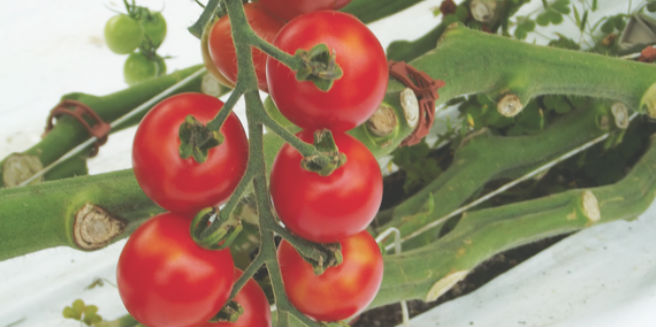Feb 22, 2017Tomato nutrients linked to pH, phosphorus management
Working with collaborating farms and Extension educators across New York state, the Cornell Vegetable Program is gaining valuable insight into the dynamics of soil and plant nutrient status coupled with on-farm management, said Judson Reid, Cornell Cooperative Extension vegetable specialist.
“Our focus has been on high tunnel tomatoes, due to their high return per square foot,” Reid said. “On these farms we conduct pre-season soil tests then work with farmers to fine- tune amendments both to reduce over application of nutrients, and at the same time maximize yield and return. In season we take regular foliar tests to help make decisions for optimal nutrient levels in the plant. We have data from over 40 farms across the state reflecting different management approaches, including both certified organic and conventional.”
Reid said a problem common to all types of high tunnel operations has been the escalation of root zone pH and alkalinity.
“As irrigation water is often high in pH and bicarbonate, high tunnel soils generally climb the pH scale without precipitation to leach through the profile,” he said. “The result of is lower nutrient levels in the plant foliage, ultimately decreasing vigor and yield. Manganese (Mn) deficiency is often the first sign of this problem.”
Reid said Mn deficiency often occurs mid-level in the canopy as bright yellow margins leading to marginal necrosis. There is no lack of Mn in the soil, but the pH prevents its uptake. Chelated manganese is available to raise the level in the plant, but this is treating the symptom instead of the underlying cause of pH and alkalinity.
The first step in addressing the pH/ alkalinity is to test irrigation water for both pH and bicarbonates, Reid said. Water pH can be measured with a digital meter, but alkalinity requires a lab test.
“With these two figures we can then use an online calculator from University of New Hampshire to calculate a quantity of acid to inject into our irrigation water,” he said. “The two common acids are phosphoric and sulfuric.”
Reid said organic growers can use citric acid, however there is no tool to calculate the quantity needed. A gradual addition of citric acid to the system while monitoring irrigation water pH is the common approach.
“Another important step is to acidify the soil profile prior to planting with elemental sulfur,” he said. “Sulfur is slow to react so fall applications are advised. Rates will vary based on soil levels of calcium and pH.”
Another trend among Cornell’s research sites has been excessive phosphorus levels, Reid said.
“Spring fertility management for tomatoes often emphasizes phosphorus. This makes sense given the importance of phosphorus in root growth. Cold soils inhibit phosphorus uptake, so many growers increase the ratio and rate of application to get the nutrient in direct contact with the roots. However, phosphorus is banked in the soil when over applied. In our sampling we have found that phosphorus levels are excessively high on many sites, sometimes several orders of magnitude above recommended levels.”
In high pH and phosphorus soils an induced zinc deficiency can occur, Reid said. Zinc is critical in a number of plant functions including flower production. Thus, there will often be a recommendation to apply zinc sulfate.
He said tomatoes only need one-half to 1-pound per acre of zinc, but it simply may not be available in these situations so application rates range from 10 pounds to 20 pounds per acre.
“If making a banded application the rate is reduced to 1-2 pounds per acre,” he said. “Zinc Sulfate is OMRI listed but the products generally carry the stipulation that it may only be used as a plant or soil amendment with a documented zinc deficiency.”
Aside from the addition of zinc there are other management steps to prevent this issue, including:
- Soil test annually in the fall to get the most accurate measure of soil P levels
- Fertilize in the spring and avoid fertilizers with a high P ratio
- Apply sulfur if pH is beginning to climb
- Lay plastic well prior to transplanting to help warm the soil. This will make P more available and reduce the need to make excess application.
- Inject sulfuric or citric acid with irrigation water to reduce alkalinity and pH problems.
- Foliar test in season to make adjustments if necessary.
— Gary Pullano, associate editor















